
System Simulation Techniques with MATLAB and Simulink
John Wiley & Sons Inc (Verlag)
978-1-118-64792-9 (ISBN)
Finally the modelling and simulation of engineering and non-engineering systems are presented. The areas covered include electrical, electronic systems, mechanical systems, pharmacokinetic systems, video and image processing systems and discrete event systems. Hardware-in-the-loop simulation and real-time application are also discussed.
Key features:
Progressive building of simulation skills using Simulink, from basics through to advanced levels, with illustrations and examples
Wide coverage of simulation topics of applications from engineering to non-engineering systems
Dedicated chapter on hardware-in-the-loop simulation and real time control
End of chapter exercises
A companion website hosting a solution manual and powerpoint slides
System Simulation Techniques with MATLAB and Simulink is a suitable textbook for senior undergraduate/postgraduate courses covering modelling and simulation, and is also an ideal reference for researchers and practitioners in industry.
Dingyü Xue received his BSc, MSc and D Phil from Shenyang University of Technology, P. R. China in 1985, Northeastern University, PRC in 1988 and Sussex University, UK in 1992, respectively. He has been in the faculty of Department of Automatic Control since 1993 and was promoted to a Professor in 1997, Northeastern University. He is now the Fellow of System Simulation Society of China (SSSC), vice-director of Education Committee of SSSC, President of Liaoning Provincial System Simulation Association. From 1988, while he was doing research work towards a D Phil in Sussex University, UK, he began utilizing MATLAB as the main tool and developed several commercial programs using MATLAB. Especially, since he took up the post in Northeastern University, he concentrated on the reform of the course of computer aided control systems design and introduced MATLAB as the main tool in the course. The book "Computer aided control systems design using MATLAB" by Tsinghua University Press in 1996 has been acknowledged as the first thorough introduction to MATLAB in conjunction with control systems in China. A series of books on the topic has been published in Tsinghua University Press since and earned the author good reputation among the Chinese readers world wide. The book has been cited by thousands of books and journal papers in China. He is the author of two books in English, "Feedback Linear Control, analysis and design with MATLAB" (SIAM, 2007) and "Solving applied mathematical problems with MATLAB" (CRC, 2008). The major research interest of Professor Xue covers the areas of CACSD, systems simulation, system modelling and identification. He has published many papers and books and developed a freely downloadable MATLAB based feedback control systems analysis and design tool CtrlLAB. YangQuan Chen joined the School of Engineering at the University of California, Merced in Fall 2012 where he formally teaches Mechatronics and Fractional Order Mechanics. He founded the MESA Lab (Mechatronics, Embedded Systems and Automation) with research emphasis and excellence in Unmanned Aerial Systems and UAV-based Personal Remote Sensing, Cyber-Physical Systems (CPS), Modeling and Control of Renewable Energy Systems, Mechatronics, and Applied Fractional Calculus (AFC). He earned his Ph.D. in 1998 from Nanyang Technological University, Singapore. From 2000-2012, Dr. Chen was a faculty member at Utah State University (USU) where he directed the CSOIS (Center for Self-Organizing and Intelligent Systems) from 2004-2012. The most important award he received was the "Relationship Counselor" award from USU Student Branch of IEEE for "explaining human relationships with control theory." He is a recipient of IFAC Best Journal Paper Award (Control Engineering Practice) at 2011 IFAC World Congress. He is a member of the editorial board for several leading journals such as Fractional Calculus and Applied Analysis, IFAC Control Engineering Practice, IEEE Transactions on Control Systems Technology, IFAC Mechatronics, ASME Journal of Dynamic Systems, Measurement and Control, Journal of Intelligent and Robotic Systems, and ISA Transactions. He is the Topic Editor-in-Chief of Field Robotics for International Journal of Advanced Robotic Systems and he is also a founding editorial board member for Unmanned Systems (World Scientific). His most recent monographs are "Distributed-Order Dynamic Systems: Stability, Simulation, Applications and Perspectives" (with Z. Jiao and I. Podlubny, Springer, 2012), "Fractional Order Motion Controls" (with Y. Luo, Wiley, 2012), "Remote Sensing and Actuation Using Unmanned Vehicles", (with H. Chao, Wiley-IEEE Press, 2012) and "System Simulation Techniques with MATLAB and Simulink" (with D. Xue, Wiley, 2013).
Foreword xiii
Preface xv
1 Introduction to System Simulation Techniques and Applications 1
1.1 Overview of System Simulation Techniques 1
1.2 Development of Simulation Software 2
1.3 Introduction to MATLAB 5
1.4 Structure of the Book 7
Exercises 9
References 9
2 Fundamentals of MATLAB Programming 11
2.1 MATLAB Environment 11
2.2 Data Types in MATLAB 13
2.3 Matrix Computations in MATLAB 16
2.5 Programming and Tactics of MATLAB Functions 23
2.6 Two-dimensional Graphics in MATLAB 27
2.7 Three-dimensional Graphics 33
2.8 Graphical User Interface Design in MATLAB 36
2.9 Accelerating MATLAB Functions 52
Exercises 60
References 63
3 MATLAB Applications in Scientific Computations 65
3.1 Analytical and Numerical Solutions 66
3.2 Solutions to Linear Algebra Problems 67
3.3 Solutions of Calculus Problems 85
3.4 Solutions of Ordinary Differential Equations 91
3.5 Nonlinear Equation Solutions and Optimization 110
3.6 Dynamic Programming and its Applications in Path Planning 120
3.7 Data Interpolation and Statistical Analysis 124
Exercises 136
References 142
4 Mathematical Modeling and Simulation with Simulink 145
4.1 Brief Description of the Simulink Block Library 146
4.2 Simulink Modeling 159
4.3 Model Manipulation and Simulation Analysis 164
4.4 Illustrative Examples of Simulink Modeling 172
4.5 Modeling, Simulation and Analysis of Linear Systems 180
4.6 Simulation of Continuous Nonlinear Stochastic Systems 184
Exercises 188
References 191
5 Commonly Used Blocks and Intermediate-level Modeling Skills 193
5.1 Commonly Used Blocks and Modeling Skills 193
5.2 Modeling and Simulation of Multivariable Linear Systems 202
5.3 Nonlinear Components with Lookup Table Blocks 209
5.4 Block Diagram Based Solutions of Differential Equations 217
5.5 Output Block Library 226
5.6 Three-dimensional Animation of Simulation Results 238
5.7 Subsystems and Block Masking Techniques 245
Exercises 260
References 264
6 Advanced Techniques in Simulink Modeling and Applications 265
6.1 Command-line Modeling in Simulink 265
6.2 System Simulation and Linearization 272
6.3 S-function Programming and Applications 280
6.4 Examples of Optimization in Simulation: Optimal Controller Design Applications 296
Exercises 303
References 306
7 Modeling and Simulation of Engineering Systems 307
7.1 Physical System Modeling with Simscape 308
7.2 Description of SimPowerSystems 318
7.3 Modeling and Simulation of Electronic Systems 322
7.4 Simulation of Motors and Electric Drive Systems 336
7.5 Modeling and Simulation of Mechanical Systems 346
Exercises 360
References 362
8 Modeling and Simulation of Non-Engineering Systems 363
8.1 Modeling and Simulation of Pharmacokinetics Systems 363
8.2 Video and Image Processing Systems 376
8.3 Finite State Machine Simulation and Stateflow Applications 390
8.4 Simulation of Discrete Event Systems with SimEvents 408
Exercises 416
References 417
9 Hardware-in-the-loop Simulation and Real-time Control 419
9.1 Simulink and Real-Time Workshop 419
9.2 Introduction to dSPACE and its Blocks 429
9.3 Introduction to Quanser and its Blocks 430
9.4 Hardware-in-the-loop Simulation and Real-time Control Examples 433
9.5 Low Cost Solutions with NIAT 439
9.6 HIL Solutions with Even Lower Costs 446
9.6.3 The MESABox 449
Exercises 450
References 451
Appendix: Functions and Models 453
Index 459
| Verlagsort | New York |
|---|---|
| Sprache | englisch |
| Maße | 185 x 262 mm |
| Gewicht | 957 g |
| Themenwelt | Mathematik / Informatik ► Mathematik ► Angewandte Mathematik |
| Technik ► Elektrotechnik / Energietechnik | |
| Technik ► Maschinenbau | |
| ISBN-10 | 1-118-64792-0 / 1118647920 |
| ISBN-13 | 978-1-118-64792-9 / 9781118647929 |
| Zustand | Neuware |
| Informationen gemäß Produktsicherheitsverordnung (GPSR) | |
| Haben Sie eine Frage zum Produkt? |
aus dem Bereich


